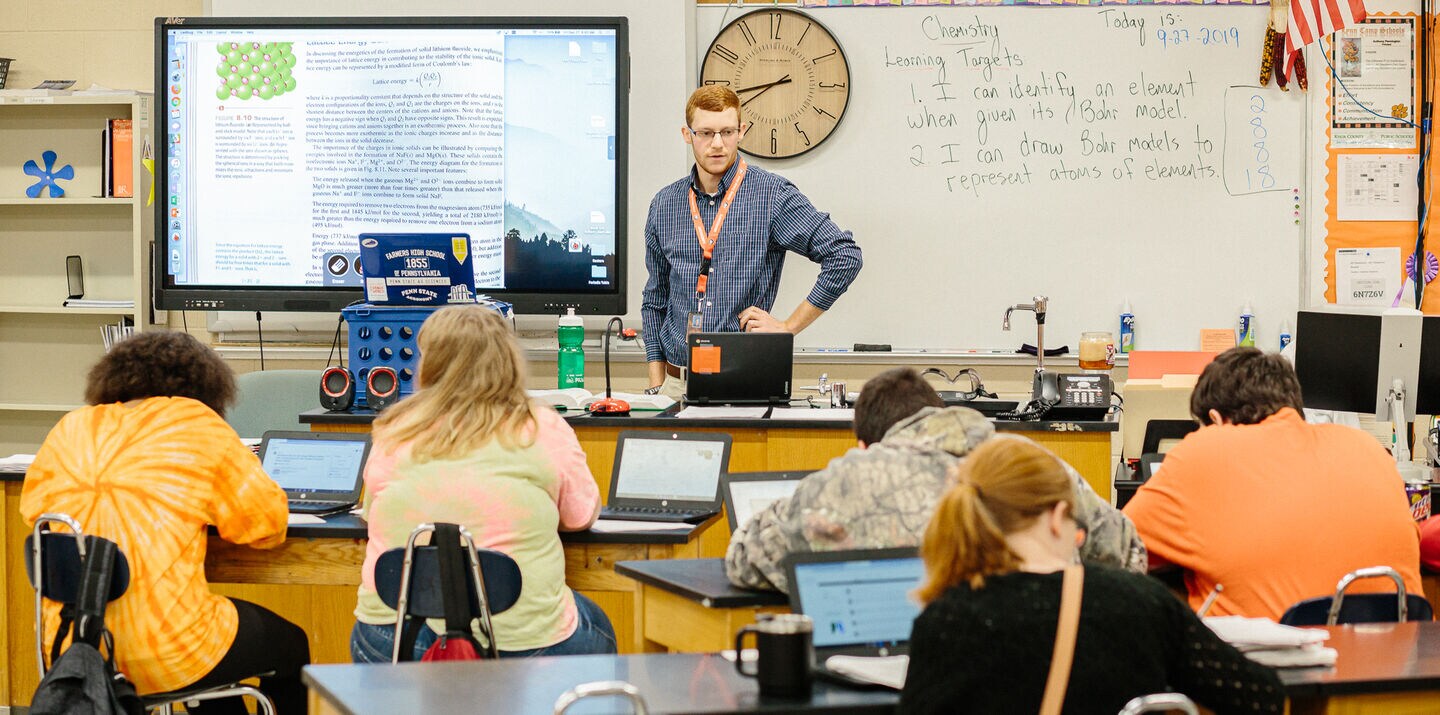
What's Possible for Appalachia’s Schools When Internet Isn't an Issue
Some schools in Eastern Kentucky are equipped with state of the art classroom technology and the high-speed internet necessary to run it, allowing them to focus on preparing students for a 21st-century future in the region.
In Inez, KY, there’s a road where Highway 645 suddenly ends. It’s easy to miss, and you might think you’re going the wrong way, but keep driving. Take a left at the exit cut between two tall, exposed layers of rock and continue up the steep winding road. At the top of that hill, surrounded by tall trees, you’ll find the new Martin County High School.
The sprawling $32 million dollar building replaced the old Sheldon Clark High School, which was far too outdated—and small—for students in 2019.
“We were there for six years, and it was an older middle school building with a lot of different issues, and we all just accepted it,” says Martha Williams, the principal of Martin County High School. “It was crowded. The classrooms were not set up for high school kids, they were for middle school kids. Some of them were just jam packed, the hallways were jam packed.”
With its high ceilings and 132,000 square feet of space, that’s not a problem anymore. Along with a new auditorium equipped with a production studio and green room, the new Martin County High School boasts a commercial food laboratory, an aerospace lab, a robotics lab, and a new gym that seats 2,000 people for games and events. There are speakers and microphones in each classroom to make education more accessible for deaf and hard-of-hearing students.
Most importantly, the school is equipped with brand new Wi-Fi access points to support the school’s internet usage.
Martin County is one of a number of counties in Eastern Kentucky where newly expanded internet access and greater investment in education are finally inspiring a renewed sense of possibility and hope for teachers, families, and students. The new school brings optimism to a county that struggles with the challenges of economic hardship and poor health outcomes.
Educators and school leaders in Martin County have the urgent task of making sure their students receive the education and career training they need to overcome these obstacles and lead successful lives. But with their new state-of-the-art high school, these challenges seem more surmountable than ever before.
By spending less time focusing on whether the Wi-Fi is working, educators now have more time to prepare students for the challenges of the 21st century—the way urban and suburban schools that take high-speed internet for granted have been able to for years.
New High School, New Tech
In addition to building a new high school, officials put a great deal of time and resources into expanding internet access in Martin County. “About five or six years ago, the internet access throughout Martin County was an area that was a vital concern,” Martha explains. Now, the average internet download speed in Inez, where Martin County High School is located, is now an impressive 98.54 mbps.
This high-speed internet expansion is key to supporting the new technology being introduced at the school. For Emaleigh Osborn, the new Martin County High School opens up so many opportunities for her classroom. Emaleigh was born and raised in Martin County, and decided to join Teach For America in 2016 to make a difference in the community where she grew up.
“At the old school we did have all of the stuff that we needed to run good enough internet, but it wasn't very reliable at all," she says. "We had to schedule our exams with that in mind. So we would only have a certain fraction of the students taking their test at a time or else it would crash.” Teachers also had to schedule around Chromebook availability, because there weren’t enough computers for each student. That’s no longer at problem at the new school.
Emaleigh is a chemistry teacher and Google level two certified educator who is completing her masters’ degree in teacher leadership with an emphasis on instructional technology.
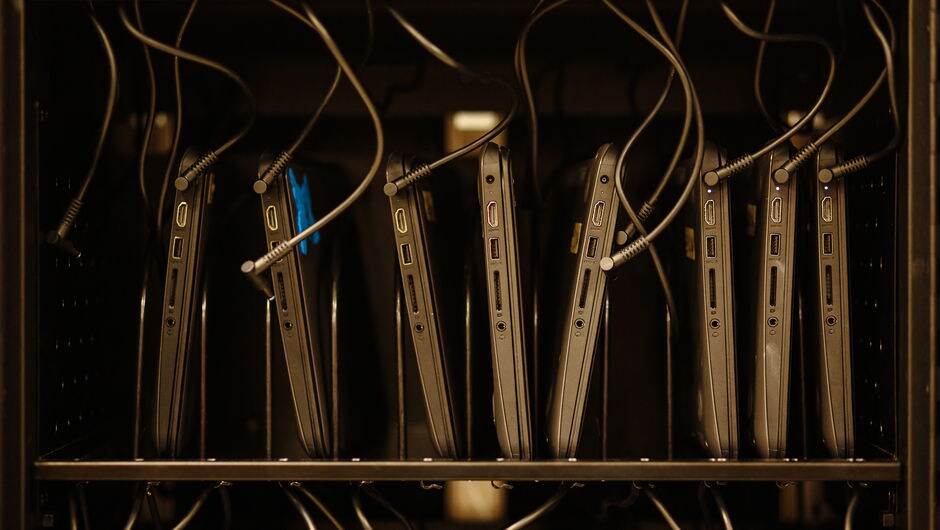
“Now, the idea is for every teacher to implement more technology inside the classroom. We now have smartboards, which are laser interactive and come with science programs pre-loaded,” Emaleigh says. “With chemistry, it's very abstract, it’s very hard for students to imagine things. So my favorite part is, you can pull up a periodic table right from there.”
For Allison Leip, an English teacher at Martin County High School, the new school means that her students can regularly use computers in class, typing and improving their computer literacy skills instead of writing by hand.
Allison grew up in Florida and moved to Eastern Kentucky in 2017 to join Teach For America. Since joining Martin County High School, Allison has become passionate about building a classroom library that is representative of Appalachian culture and including Appalachian literature in her curriculum.
Posted all around Allison’s classroom are handmade signs about grammar topics such as articles and prepositions. Despite being an admitted paper person herself, Allison wants her students to be typing up their assignments as much as possible. This is important, because in Kentucky, students are required to complete two typed essays in order to pass their state tests and graduate high school.
“When we moved into this new school they asked us, ‘What technology do you feel is necessary?’ They had invested in new computers for teachers and new technology for teachers. I went to them and said, ‘Listen, my kids are held accountable in the 11th grade to type not one but two essays that are timed,’” she explained. “‘In the classroom, I feel like it should reflect that.’”
This is the school's first year, and a month into the semester, the finishing touches on the school’s digital infrastructure were still in progress. But for the teachers of Martin County High School, a few more weeks of waiting was well worth it, considering all of the possibilities the school’s new technology would bring to their students.
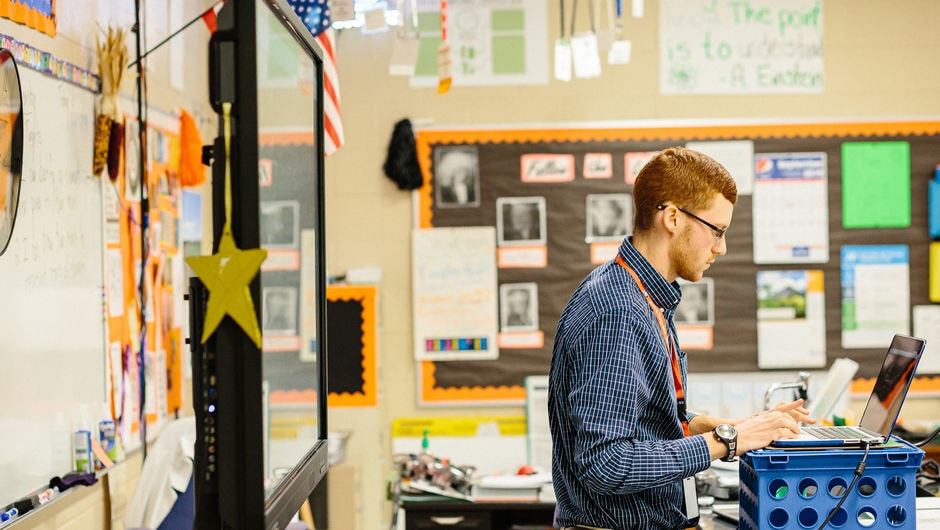
What Tech Looks like in Lynn Camp High School
On the other side of Eastern Kentucky, nestled near the Tennessee border, between the Daniel Boone National Forest and acres of rolling farmland, the students of Lynn Camp High School were busy putting their final touches on their Spirit Week decorations. Up and down the upperclassmen hallways were lockers covered in paper recreations of popular Nickelodeon cartoons and posters for student president candidates.
It was Friday and the powderpuff football game was set for that afternoon, so the school was buzzing with excitement. But in Jonathan Stephen’s classroom, covered wall-to-wall in nerdy posters and funny chemistry memes, the ambience was much more serene.
Jonathan moved to Kentucky in 2018, when he joined Teach For America. He grew up in rural Pennsylvania, so he shares a similar upbringing to his students. The Appalachian mountain range that runs through Eastern Kentucky also runs along his hometown. “This is not all that new to me, besides extra biscuits and gravy,” Jonathan says with a chuckle.
Relaxing music played from the class smartboard as Jonathan’s AP Chemistry students logged onto Google Classroom for an interactive game. In the game, each student was represented by an avatar on the smartboard. As they submitted their answers via their chromebooks, those avatars would pop up. After each question, Jonathan would explain the correct answer, using the smartboard to zoom into a certain chemical compound or circle a part of the periodic table of elements to support his explanation.
For as tricky a subject as AP Chemistry, Jonathan’s students were engaged, confident, and—most importantly—having fun because of the gamification of the subject. This is Emaleigh’s dream of a tech-enabled science classroom realized.

The Benefits Students and Teachers Get From Ed Tech
Although they’re in different communities on opposite sides of Eastern Kentucky, both Lynn Camp and Martin County High Schools have benefited from the push to expand internet access over the past few years.
These new and improved speeds are in part a result of a bipartisan state-run project called KentuckyWired. The project aims to build 3,000 miles of fiber optic cable loops through every county in Kentucky, with a focus on creating a “middle mile” of internet network that connects essential institutions like schools and government buildings with high-speed internet.
This makes it easier for teachers to center their curricula around the digital learning their students will need to be successful after high school. “I think we've been a little bit behind with our technology,” Martha, the Martin County principal, says. “But with the new school and everything, that's going to provide more availability for the students to have the equipment and especially the facilities and the space to practice those skills.”
This availability can truly make a difference for students. One report from the Stanford Center for Opportunity Policy in Education (SCOPE) found that well-implemented classroom technology can result in significant gains in student achievement and engagement, particularly among low-income students and students of color.
It also helps educators, who always have a ton of work on their plate, operate more efficiently. Jonathan calls Google Classroom his “pot of gold.” He also loves GradeCam, an app that tracks student test scores and progress.
“If you're waiting for all the teachers to get their data in excel and make a graph, it's just not going to happen,” Jonathan explains. “But with the app, you can take a picture and it grades the test instantly. It provides some really nice data as far as your bell curves and how students are doing.”
With all of this technology, Jonathan can spend less time grading and more time teaching. It also gives Jonathan valuable insights into which parts of the curriculum students are excelling in and which parts they may need additional help with.
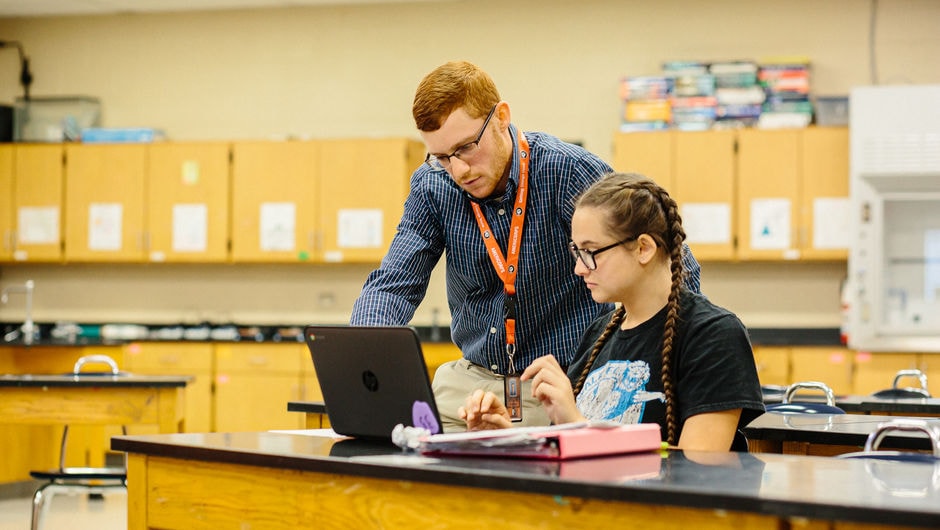
Paving the Way for What’s Next for Appalachia
Of course, having more schools in Appalachia with access to this kind of technology will not solve the region’s challenges alone. Both education and economics are key to the revitalization of Appalachia. Without the prospect of local economic opportunity to work toward, students will only be pushed to leave and seek jobs and education elsewhere.
That’s why school leaders like Martha have a tricky but urgent task: looking ahead and trying to determine which industries show promise in bringing good-paying, sustaining jobs to the region. Then, tailor the curriculum accordingly.
For example, aerospace and aviation are industries with growing prominence in Kentucky, as it is home to corporations like Boeing and Lockheed Martin. Jobs in these fields are appealing options for students who want to pursue science, technology, engineering and math (STEM) careers while staying close to home.
That’s why schools like Martin County High School are investing in a robust aerospace training program, says Roscoe Mullins, the Department of Education IT coordinator for Martin County. “It gives those kids a leg up.”
Roscoe works out of the DOE building right off of Main Street in downtown Inez, where the sweet smell of kudzu hangs heavy in the air. He’s played an instrumental role in helping to set up the new technology at Martin County. Roscoe hopes the school’s new career training technology will give students something to aspire toward.
“I think most importantly for the people of Eastern Kentucky, it gives the kids an opportunity to develop their dream. The biggest problem I see is in living in a small town, with not a lot of stuff going on, you don't have dreams of becoming something that you've not been exposed to,” Roscoe says. “This exposes the kids to something that might be a really good career path and not be so far from home.”
For Jared Arnett, the executive director of Shaping Our Appalachian Region (SOAR), his vision of Appalachian revitalization goes beyond ensuring students have skills that match the industry demands in Kentucky. He wants students to be empowered to create their own businesses and industry, for and by Eastern Kentucky.
As a proud native Eastern Kentuckian and entrepreneur who has been involved with over 10 successful startups in the region, Jared believes ingenuity is part of what it means to be Appalachian. Technology is simply the next way of exploring that ingenuity, and it will require investment in K-12 programs that expose students to career pathways and training related to STEM, digital economy skill sets, agribusiness, and other emerging technologies.
In 2017, SOAR helped Martin County build the Dream Discovery Center, a makerspace in Inez where students can access a coding laboratory, a LEGO robotics laboratory, 3-D printers, and other emerging technologies.
SOAR is also seeing great progress in its work to expand economic opportunity. Through its grassroots partnership with Teleworks USA, the region has seen the creation of over 2,500 remote work jobs in the past four years. Since SOAR was founded in 2013, its systemic approach has enabled the creation of over 5,000 new jobs in the region. Half of those jobs are remote work, according to Jared, and most of them require dependable, fast high-speed internet access. The others are entrepreneurial startups, new companies that have come in, and hospital expansions.
This is a huge economic boost to the region. But there’s still more work to be done and Jared has bold visions for the future. “We want to see more remote work opportunities and more access to local healthy foods, farmers' markets, and farm to school programs,” he says. “We want to see Appalachia become a destination from a tourism perspective.”
By exposing their students to a robust technology curriculum early on, educators and school leaders are preparing kids to be the stakeholders of this growing economic vision in Eastern Kentucky.
“Education is an important piece of the puzzle,” Jared says. “But if there's no economic opportunity in the community, then we're just training people to leave.”
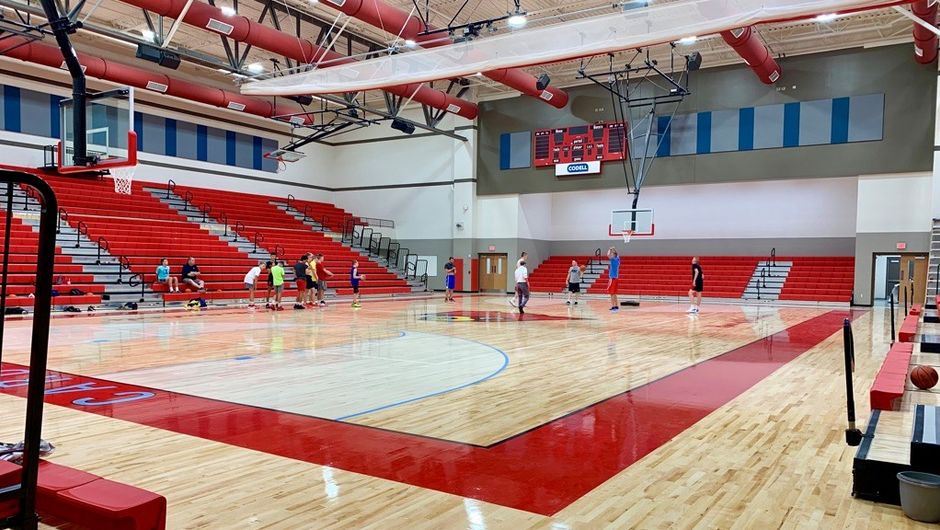
Investing in Students Pays Dividends
The long-term economic and educational benefits of exposing Appalachian students to new technology are clear. But there are immediate benefits to this investment as well, like student confidence.
Since the start of the school year at Martin County High School, Martha Williams, the principal, has noticed an increase in student morale and engagement. “I've really seen a change in school culture and students taking pride and ownership,” Martha says. “I hope that reflects in their improved scores and everything over this year because ultimately, that's what it's about, it's academic attainment.”
Allison has noticed it too. Students are more likely to come to school ready to learn and to stay after for extracurriculars, she says. They just seem more optimistic.
This feeling is so important for students in Appalachia, who are too often absorbing media and stereotypes that portray the region as having less than others, as being behind others. But when students see the new facilities in their schools, when they have carts of new Chromebooks as part of their daily learning, and when they know their school has some of the best internet in the county, they feel invested in. And it shows.
Outside of the Martin County High School gymnasium, equipped with fresh red bleachers and a gleaming floor emblazoned with the school’s cardinal mascot, a group of 11th-grade students took a quick break from playing volleyball to share their thoughts with me.
“We have a whole new high school,” Jada says.
“We’ll get stuff done faster. Any of our testing, any work. It's just easier online. I feel like it makes it a lot better to come to school, too,” Madison says. “We have something to really be proud of.”
“We really do,” Jada agreed.
We want your feedback. Share your thoughts on this story or suggest other stories for us to pursue.
Sign up to receive articles like this in your inbox!
Thanks for signing up!
Content is loading...








